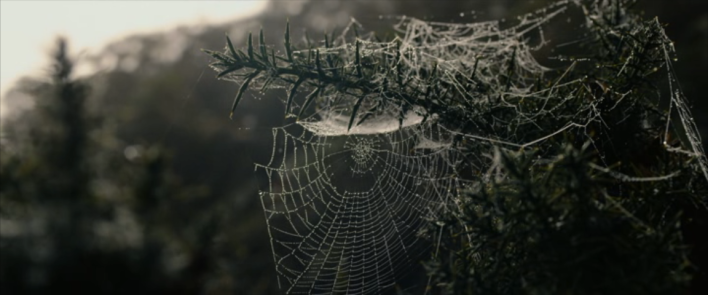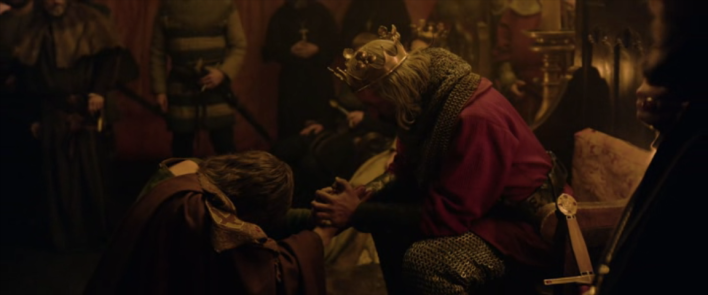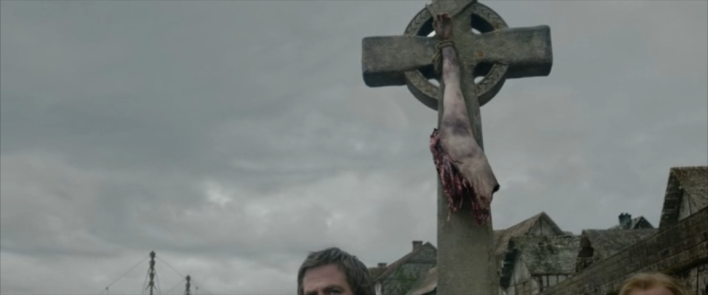Outlaw King. 2018. Directed by David Mackenzie. Screenplay by Bathsheba Doran, David Mackenzie, & James MacInnes.
Starring Chris Pine, Stephen Dillane, Rebecca Robin, Billy Howle, Callan Mulvey, Steven Cree, Tony Curran, James Cosmo, Alastair Mackenzie, & Aaron Taylor-Johnson.
Clockwork Sessions/Sigma Films/Anonymous Countent
Rated R. 121 minutes.
Action/Biography/Drama/History
★★★★
 David Mackenzie’s latest film goes back to his homeland, Scotland, and takes on one of its biggest national heroes: Robert the Bruce. The man was most famously portrayed by Angus Macfadyen in the chest thumping 1995 war epic, Braveheart. Here we see the legendary figure in a way that strips him down to his roots, sparing the myth-making for a bare bones perspective on the Bruce’s fight for Scottish independence.
David Mackenzie’s latest film goes back to his homeland, Scotland, and takes on one of its biggest national heroes: Robert the Bruce. The man was most famously portrayed by Angus Macfadyen in the chest thumping 1995 war epic, Braveheart. Here we see the legendary figure in a way that strips him down to his roots, sparing the myth-making for a bare bones perspective on the Bruce’s fight for Scottish independence.
This story evades visualising the mythologised portions of Robert’s life. Mackenzie doesn’t opt for recreating a scene of the Bruce hiding in a cave after the Battle of Methven in 1305 where he watched a spider spin its web, or the crushing blow he laid upon Henry de Bohun as they fought during the Battle of Bannockburn when he supposedly crushed de Bohun’s helmet and skull in one vicious strike.
By not focusing on folklore or mythology, Mackenzie keeps Outlaw King from becoming nothing but a war cry of a film. The story’s able to bring to life Robert the Bruce’s personality. This doesn’t mean the war scenes are lacking. In fact, they’re undeniably gory. What’s evident throughout is the character of King Robert. We see him as an atypical king, unlike the English king against whom he rebelled. Most importantly, we see him as a king truly unconcerned with himself, wholly intent on liberating his people.
 Although Robert was of nobility, descended from a line of aristocrats, his attitude wasn’t typically aristocratic with notions of control and power. What defined him was a different sense of kingship. Whereas the British treated their king like a mythic, infallible deity, the Bruce insisted on being one with his men— a flesh and blood king. Numerous visuals convey this man-of-the-people perspective. In one scene, a boy bows to King Robert, then Robert kneels next to him, and on other occasions, Robert refuses to watch people kneel in front of him, a symbolic rejection of the separation between classes like that between the citizens of England and its royalty. During a later scene, men come to pledge their allegiance to the King of Scots and fight by his side, only to find him filthy in the mud digging trenches next to his infantry.
Although Robert was of nobility, descended from a line of aristocrats, his attitude wasn’t typically aristocratic with notions of control and power. What defined him was a different sense of kingship. Whereas the British treated their king like a mythic, infallible deity, the Bruce insisted on being one with his men— a flesh and blood king. Numerous visuals convey this man-of-the-people perspective. In one scene, a boy bows to King Robert, then Robert kneels next to him, and on other occasions, Robert refuses to watch people kneel in front of him, a symbolic rejection of the separation between classes like that between the citizens of England and its royalty. During a later scene, men come to pledge their allegiance to the King of Scots and fight by his side, only to find him filthy in the mud digging trenches next to his infantry.
The defining visuals epitomising Robert’s sense of “fighting for the people” come in the opening scene and the end of the last battle. The film’s first scene depicts King Edward I of England (Stephen Dillane) receiving the surrender of Scottish nobleman. We find Robert in the midst of bowing to the king. This moment sits in contrast with the end of the film’s final battle which depicts the Battle of Loudoun Hill. After the fighting’s over, Robert finds the boy who earlier returned his crown. The King of Scots kneels beside the dying boy in the mud and they hold the crown together as one – two warriors on equal ground – in stark juxtaposition with his opening scene being forced to bow to a man who barely saw the periphery of a battlefield as king.
What this notion of a king amongst men boils down to is Robert wasn’t afraid to show himself as nothing but a man, with no problem bleeding, sweating, or crying with his people. In a scene where Robert’s reeling in tragedy, he begins singing, joined by his men. Another scene where the men dig with their king involves a song as they work. Not only do these moments illustrate Scottish strength through song, it’s symbolic of the King of Scots being like everyone else— he doesn’t sit on a throne being sung to, he sits with his men singing with them.

“I know you all as men, but today— today, we are beasts.”
 Despite Robert’s attitude as king going against the established order, he had to deal with the hideous “nature of power.” Not much has changed in the sense “the price you pay” for being a political leader involves having your loved ones put in danger and, sometimes, maybe even murdered. In the 14th century, Robert had to deal with members of his family being slaughtered, others held captive. He was seen as a ‘rebel king’ by the English, and, as it is in many cases for those deemed rebels by the ruling class, he and the people who followed him had to sacrifice their lives and/or the lives of those they loved in order to achieve independence.
Despite Robert’s attitude as king going against the established order, he had to deal with the hideous “nature of power.” Not much has changed in the sense “the price you pay” for being a political leader involves having your loved ones put in danger and, sometimes, maybe even murdered. In the 14th century, Robert had to deal with members of his family being slaughtered, others held captive. He was seen as a ‘rebel king’ by the English, and, as it is in many cases for those deemed rebels by the ruling class, he and the people who followed him had to sacrifice their lives and/or the lives of those they loved in order to achieve independence.
Bruce and those he fought beside don’t represent nationalism. They’re ancestral symbols of those who refuse to be denied autonomy as citizens and as people. The story’s violent, often brutally so, and concerns the power of a nation/a national heroic figure, yet Outlaw King is about the spirit of all those disenfranchised by a corrupt ruling class. Doesn’t matter the Bruce was a nobleman in his homeland, given England and its king were ruling over Scotland, oppressing its citizens. People like Robert, and of course William Wallace, among others, were the guerrilla leaders of the Middle Ages, after the ancient tribes before them and well prior to revolutionaries like Emiliano Zapata. They were fighting against having their ways of life eradicated. In one scene, Scots are referred to derogatorily as “These people” by English soldiers. Easy to see the Scottish under Robert using guerrilla warfare as a last vestige of the unheard, as it is today, used to disrupt the status quo and take power away, if but momentarily, from those who wield it.
Many white nationalists are desperate to see this type of medieval story as a parallel to white fears of multiculturalism. However, Robert and his Scots have more in common with people of colour who’ve experienced the ravages of colonialism than with modern whites. Up until the 17th and 18th centuries, certain pockets of English society regarded the Scottish people as barbaric, lawless, and ‘savages’— this last word particularly strikes of the same attitude white colonialists have towards Indigenous peoples. During one scene, an Englishman says it doesn’t matter what happens when “dealing with outlaws” because “they have no rights.” The ugly irony is the Englishmen see the Scottish clans as animals, when in an early scene we see they’ve distributed the limbs of William Wallace to four different locations from England to Scotland. At its core, the screenplay involves a fight for human rights as opposed to the rights given out by the church or the state.
 In Scotland, Robert’s a legend near mythic in status. Outlaw King takes nothing away from this by focusing on the man himself. Mackenzie’s film poses the Bruce as a symbol of fiercely independent Scottish pride— a pride which exists to this day in those who rebel against being controlled solely by outside interests, whether England, or Trump shitting all over the natural landscape trying to build one of his bourgeois golf resorts.
In Scotland, Robert’s a legend near mythic in status. Outlaw King takes nothing away from this by focusing on the man himself. Mackenzie’s film poses the Bruce as a symbol of fiercely independent Scottish pride— a pride which exists to this day in those who rebel against being controlled solely by outside interests, whether England, or Trump shitting all over the natural landscape trying to build one of his bourgeois golf resorts.
Robert stands as one of those historical leaders who represents what power can do when it’s on the side of the people versus when ruling others becomes less about providing the best conditions for citizens and more about authoritative control. His status as a nobleman coupled with his spirit and behaviour as a king on the battlefield alongside his men makes his quest for independence all the more compelling on a human level. The image of King Edward I only close enough to battle to watch a trebuchet launch is telling, as we witness a dozen moments of Robert on the battlefield or training, refusing to be anywhere but in the middle of the fight.
Outlaw King didn’t get a warm reception during its TIFF premiere. Father Gore’s not going to be the one to tell you critics were wrong, neither will he try convincing you Mackenzie chopping 20 minutes from his film is the magical key to unlocking his work’s excellence. Certain viewers and critics won’t be as thrilled with this film. This historical war epic’s sense of realism keeps it from sensationalism, never sacrificing any of its emotional intensity. This won’t be everyone’s favourite. For some, it’ll speak volumes to their sense of independence— Scottish or otherwise.


Pingback: Reviews: Outlaw King (2018) – Online Film Critics Society
It’s true it shifts away from scenes like the spider in the cave, but it also uses some artistic freedom ‘Braveheart style’ when chooses to depict Elizabeth being caged. And it was Mary Bruce, Robert’s sister who was caged, not Robert’s wife. And Neil Bruce wasn’t hanged in front of Robert’s family neither. Given these details it’s a pity they chose not to display the scene of the spider, which al least it teaches a beautiful message that rings perfect with Robert the Bruce, never give up!
Like
Absolutely. Changing historical bits and pieces slightly is standard for screenplays. As far as the spider, I do love that image of Robert, but in a film like this it just wouldn’t have fit.
LikeLike